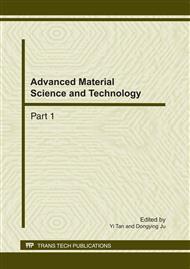p.357
p.361
p.365
p.369
p.375
p.379
p.383
p.387
p.391
Structure and CO Gas Sensing Properties of PPy/LaFeO3 Nanocomposites
Abstract:
In this paper, perovskite LaFeO3 nanoparticles were synthesised by a sol-gel method. Then, polypyrrole (PPy)/LaFeO3 nanocomposites were prepared by a simple in situ chemical polymerization method. By means of X-ray diffraction (XRD), Fourier transform infrared (FTIR) and scanning electron microscopy (SEM), the microstructure of PPy/LaFeO3 nanocomposites was characterized. The XRD patterns indicated that LaFeO3 nanoparticles have a perovskite phase with orthorhombic structure, and incorporation of PPy did not change the crystalline structure of LaFeO3. The PPy was evenly dispersed on the surface of LaFeO3 particles, which was endorsed by FTIR spectral analyses. And SEM images indicate that the PPy was evenly dispersed on the surface of LaFeO3 particles without apparent agglomeration. And we found that the nanocomposites exhibited a higher response to CO gas.
Info:
Periodical:
Pages:
375-378
Citation:
Online since:
February 2011
Keywords:
Price:
Сopyright:
© 2011 Trans Tech Publications Ltd. All Rights Reserved
Share:
Citation:


